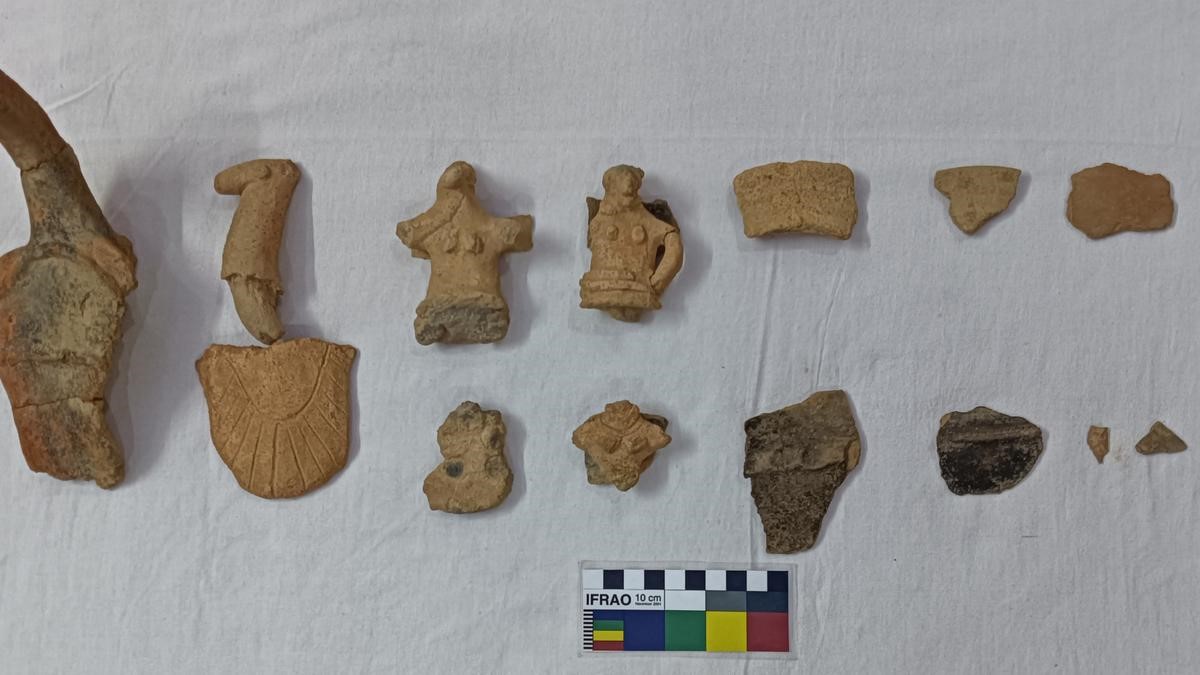Description

Disclaimer: Copyright infringement not intended.
Context
- The discovery of unique terracotta figurines in the megalithic dolmen site near Moodbidri, Dakshina Kannada, is a significant archaeological find.
- According to historian T. Murugeshi, who was involved in the explorations, these figurines date back to 800-700 B.C.
Details
Figurines and Their Types
- Eight figurines were found during the exploration.
- These include two cow bovines, one mother goddess, two peacocks, a horse, a hand of a mother goddess, and an unknown object.
- Each of these figurines provides valuable insights into the culture and beliefs of the people from that era.
Megalithic Dolmen Site
- The site at Mudu Konaje was first discovered and reported by historian and researcher Pundikai Ganapayya Bhat in the 1980s.
- It's described as the largest megalithic dolmen site in the area, featuring nine dolmens on the slope of a stone hill.
- Unfortunately, only two dolmens remain intact, while the rest of the burials have been ruined over time.

Megalithic Culture
- The presence of megalithic dolmens at the site is a reflection of the megalithic culture known for its distinctive types of burials and the use of iron in India.
- Dolmens are characterized by the erection of large stone slabs (orthostats) in a clockwise order, creating a square room.
- These chambers were sealed with another massive stone slab as a capstone, typically featuring a round or U-shaped entrance on the Eastern slab.
Terracotta Figurines
- The terracotta figurines discovered at Mudu Konaje within the megalithic context are considered a rare find in India.
- These figurines were found inside the surface of dolmens, although some had been disturbed by treasure hunters.
- The presence of cow bovines among these figurines helps determine the chronology of the dolmens.
Cultural Significance
- The presence of cow bovines and mother goddess figurines in the dolmens is of particular interest.
- Cow goddesses have parallels in other megalithic terracotta figurines found in places like Kerala and Egypt.
- These discoveries offer insights into the cultural and religious practices of the people of coastal Karnataka during the 800-700 B.C. timeframe.
Peacock and Horse Figurines
- The figurines of peacocks and a horse suggest a connection to animals in their beliefs or possibly a representation of their natural surroundings.
- The details of these figurines, such as the use of red ochre and the design of the feathers, could provide further clues about their significance.
Research Opportunity
- According to T. Murugeshi, these terracotta figurines provide a solid foundation for studying the Bhoota cult or Daiva Aradhane in coastal Karnataka during ancient times.
- The presence of these figurines in a megalithic burial context adds to our understanding of the religious and cultural practices of the region.

Conclusion
The discovery of these terracotta figurines in the megalithic dolmen site near Moodbidri is an important archaeological find that sheds light on the ancient culture and religious beliefs of the people who lived in the area around 800-700 B.C. It opens up opportunities for further research and exploration into the Bhoota cult and the historical significance of these artifacts.
|
PRACTICE QUESTION
Q. What is a defining characteristic of megalithic burials in the context of the megalithic culture?
A) Use of hieroglyphic inscriptions
B) Construction of stone circles
C) Erection of large stone slabs known as orthostats
D) Creation of elaborate underground tombs
Correct Answer: C)
|
https://www.thehindu.com/news/cities/Mangalore/ancient-terracotta-figurines-found-during-archaeological-explorations-at-megalithic-dolmen-site-near-moodbidri/article67295586.ece







